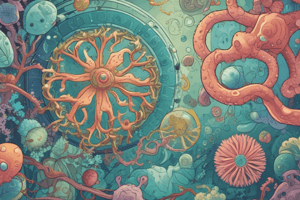Podcast
Questions and Answers
What is the primary method of reproduction in bacteria?
What is the primary method of reproduction in bacteria?
Bacteria reproduce asexually through binary fission.
Describe the composition of a virus.
Describe the composition of a virus.
A virus is composed of genetic material (DNA or RNA) surrounded by a protein coat.
What is the role of fungi in ecosystems?
What is the role of fungi in ecosystems?
Fungi play a critical role in decomposition and nutrient recycling.
How can gene transfer occur in bacteria?
How can gene transfer occur in bacteria?
What distinguishes autotrophic microorganisms from heterotrophic ones?
What distinguishes autotrophic microorganisms from heterotrophic ones?
Why are pathogenic microorganisms significant in health?
Why are pathogenic microorganisms significant in health?
What is the purpose of the Gram staining technique?
What is the purpose of the Gram staining technique?
Name a key application of microbiology in industry.
Name a key application of microbiology in industry.
Flashcards are hidden until you start studying
Study Notes
Overview of Microbiology
- Study of microorganisms: bacteria, viruses, fungi, and protozoa.
- Branches include clinical microbiology, environmental microbiology, and industrial microbiology.
Types of Microorganisms
-
Bacteria
- Prokaryotic cells, unicellular.
- Reproduce asexually through binary fission.
- Classification: gram-positive, gram-negative, anaerobic, aerobic.
-
Viruses
- Acellular, require a host to replicate.
- Composed of genetic material (DNA or RNA) surrounded by a protein coat.
- Infect various organisms, including bacteria (bacteriophages).
-
Fungi
- Eukaryotic organisms, can be unicellular (yeasts) or multicellular (molds).
- Important for decomposition and food production (e.g., bread, beer).
-
Protozoa
- Unicellular eukaryotes, often motile.
- Diverse group, including amoebas, flagellates, and ciliates.
- Can be free-living or parasitic.
Microbial Genetics
- Genetic material: DNA in bacteria (circular) and in viruses (linear or circular).
- Gene transfer: transformation (uptake of DNA), transduction (virus-mediated), conjugation (bacterial mating).
- Mutations: can lead to antibiotic resistance.
Microbial Metabolism
- Autotrophic: synthesize own food (e.g., cyanobacteria through photosynthesis).
- Heterotrophic: consume organic compounds (e.g., most fungi and protozoa).
- Anaerobic vs. Aerobic: Different energy production pathways depending on oxygen presence.
Role in Ecosystems
- Decomposers: break down organic matter, recycling nutrients.
- Symbiosis: mutualistic, commensal, and parasitic relationships with other organisms.
- Biogeochemical cycles: involved in nitrogen and carbon cycles.
Microbiology in Health
- Pathogenic microorganisms: cause diseases in humans, animals, and plants.
- Antibiotic resistance: a growing concern due to misuse of antibiotics.
- Vaccines: biological preparations that provide immunity to diseases.
Techniques in Microbiology
- Culturing: growing microorganisms in controlled environments (agar plates, broth).
- Staining: techniques like Gram staining help differentiate types of bacteria.
- Microscopy: use of light or electron microscopes for visualization.
Applications of Microbiology
- Medicine: development of antibiotics and vaccines.
- Agriculture: biopesticides and soil health.
- Industry: fermentation processes in food and beverage production.
Safety and Regulation
- Biosafety levels (BSL) categorize the containment precautions required for laboratory work with pathogens.
- Importance of aseptic techniques to prevent contamination in laboratory and clinical settings.
Overview of Microbiology
- Microbiology encompasses the study of diverse microorganisms, including bacteria, viruses, fungi, and protozoa.
- Major branches are clinical microbiology (health), environmental microbiology (ecosystems), and industrial microbiology (applications).
Types of Microorganisms
- Bacteria: Simple prokaryotic cells that reproduce asexually via binary fission; classified based on cell wall characteristics (gram-positive or gram-negative), and oxygen requirements (aerobic or anaerobic).
- Viruses: Non-cellular entities requiring a host for replication; consist of either DNA or RNA enclosed in a protein coat, capable of infecting various life forms including bacteria (bacteriophages).
- Fungi: Eukaryotic organisms that can be unicellular (yeasts) or multicellular (molds); play crucial roles in decomposition and the production of food items like bread and beer.
- Protozoa: Diverse group of motile, unicellular eukaryotes, which can be free-living or parasitic; include organisms like amoebas, flagellates, and ciliates.
Microbial Genetics
- Bacteria possess circular DNA, while viruses may have linear or circular DNA/RNA.
- Genetic transfer methods include transformation (uptake of free DNA), transduction (gene transfer via viruses), and conjugation (direct DNA transfer during bacterial mating).
- Mutations in microorganisms can lead to significant traits, such as antibiotic resistance.
Microbial Metabolism
- Autotrophic organisms: Capable of synthesizing their own food, e.g., cyanobacteria through photosynthesis.
- Heterotrophic organisms: Obtain organic compounds from their environment, e.g., most fungi and protozoa.
- Microorganisms can use different energy production pathways based on oxygen presence, categorized as anaerobic or aerobic metabolism.
Role in Ecosystems
- Microorganisms act as decomposers, breaking down organic matter and recycling essential nutrients in ecosystems.
- They engage in various symbiotic relationships, including mutualism (beneficial interactions), commensalism (neutral interactions), and parasitism (harmful interactions).
- Microbes play critical roles in biogeochemical cycles, especially nitrogen and carbon cycles, influencing overall ecosystem health.
Microbiology in Health
- Pathogenic microorganisms are responsible for diseases in humans, animals, and plants.
- The rise of antibiotic resistance presents a significant health challenge, primarily due to the misuse of antibiotics.
- Vaccines are crucial public health tools that provide immunity against various diseases.
Techniques in Microbiology
- Culturing: Involves growing microorganisms in controlled environments, commonly using agar plates or broth media.
- Staining: Techniques, such as Gram staining, differentiate species of bacteria based on cell wall structure.
- Microscopy: Light and electron microscopes are utilized for observing microorganisms at various levels of detail.
Applications of Microbiology
- In medicine, microbiology drives the development of antibiotics and vaccines to combat diseases.
- Agricultural applications include biopesticides for crop protection and enhancing soil health.
- Industrial microbiology involves fermentation processes crucial in food and beverage production.
Safety and Regulation
- Biosafety levels (BSL) provide guidelines for handling pathogens in laboratory settings, ensuring appropriate containment and safety measures.
- Aseptic techniques are essential in laboratory and clinical settings to prevent contamination and ensure the integrity of experiments and treatments.
Studying That Suits You
Use AI to generate personalized quizzes and flashcards to suit your learning preferences.




